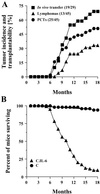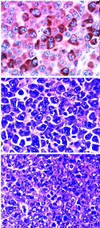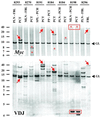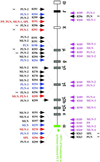IL-6 transgenic mouse model for extraosseous plasmacytoma
- PMID: 11805288
- PMCID: PMC122221
- DOI: 10.1073/pnas.022643999
IL-6 transgenic mouse model for extraosseous plasmacytoma
Abstract
Plasma cell neoplasms in humans comprise plasma cell myeloma, otherwise known as multiple myeloma, Ig deposition and heavy chain diseases, and plasmacytoma (PCT). A subset of PCT, designated extramedullary PCT, is distinguished from multiple myeloma and solitary PCT of bone by its distribution among various tissue sites but not the bone marrow. Extramedullary (extraosseus) PCT are rare spontaneous neoplasms of mice but are readily induced in a susceptible strain, BALB/c, by treatment with pristane. The tumors develop in peritoneal granulomas and are characterized by Myc-activating T(12;15) chromosomal translocations and, most frequently, by secretion of IgA. A uniting feature of human and mouse plasma cell neoplasms is the critical role played by IL-6, a B cell growth, differentiation, and survival factor. To directly test the contribution of IL-6 to PCT development, we generated BALB/c mice carrying a widely expressed IL-6 transgene. All mice exhibited lymphoproliferation and plasmacytosis. By 18 months of age, over half developed readily transplantable PCT in lymph nodes, Peyer's patches, and sometimes spleen. These neoplasms also had T(12;15) translocations, but remarkably, none expressed IgA. Unexpectedly, approximately 30% of the mice developed follicular and diffuse large cell B cell lymphomas that often coexisted with PCT. These findings provide a unique model of extramedullary PCT for studies on pathogenesis and treatment and suggest a previously unappreciated role for IL-6 in the genesis of germinal center-derived lymphomas.
Figures





References
Publication types
MeSH terms
Substances
LinkOut - more resources
Full Text Sources
Other Literature Sources
Molecular Biology Databases
Miscellaneous

